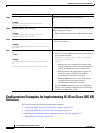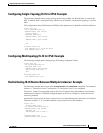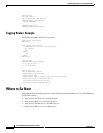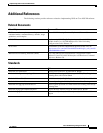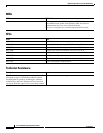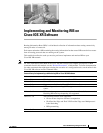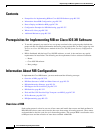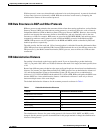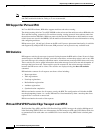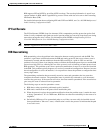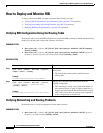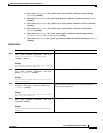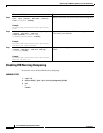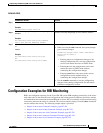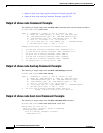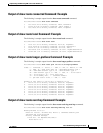
Implementing and Monitoring RIB on Cisco IOS XR Software
Information About RIB Configuration
RC-322
Cisco IOS XR Routing Configuration Guide
OL-14356-01
Note Changing the administrative distance of a protocol on some but not all routers can lead to routing loops
and other undesirable behavior. Doing so is not recommended.
RIB Support for IPv4 and IPv6
In Cisco IOS XR software, RIB tables support multicast and unicast routing.
The default routing table for Cisco IOS XR RIB are the unicast and the multicast-unicast RIB tables for
IPv4 and IPv6 routing, respectively. For multicast routing, routing protocols insert unicast routes into
the multicast-unicast RIB table. Multicast protocols then use the information to build multicast routes
(which in turn are stored in the MRIB). See the multicast documentation for more information on using
and configuring multicast.
RIB processes ipv4_rib and ipv6_rib run on the RP card. If process placement functionality is available
and supported by multiple RPs in the router, RIB processes can be placed on any available node.
RIB Statistics
RIB supports statistics for messages (requests) flowing between the RIB and its clients. Protocol clients
send messages to the RIB (for example, route add, route delete, and next-hop register, and so on). RIB
also sends messages (for example, redistribute routes, advertisements, next-hop notifications, and so on).
These statistics are used to gather information about what messages have been sent and the number of
messages that have been sent. These statistics provide counters for the various messages that flow
between the RIB server and its clients. The statistics are displayed using the show rib statistics
command.
RIB maintains counters for all requests sent from a client including:
• Route operations
• Table registrations
• Next-hop registrations
• Redistribution registrations
• Attribute registrations
• Synchronization completion
RIB also maintains counters for all requests sent by the RIB. The configuration will disable the RIB
next-hop dampening feature. As a result, RIB notifies client immediately when a next hop that client
registered for is resolved or unresolved.
RIB also maintains the results of the requests.
IPv6 and IPv6 VPN Provider Edge Transport over MPLS
IPv6 Provider Edge (6PE) and IPv6 VPN Provider Edge (6VPE) leverages the existing Multiprotocol
Label Switching (MPLS) IPv4 core infrastructure for IPv6 transport. 6PE and 6VPE enables IPv6 sites
to communicate with each other over an MPLS IPv4 core network using MPLS label switched paths
(LSPs).



